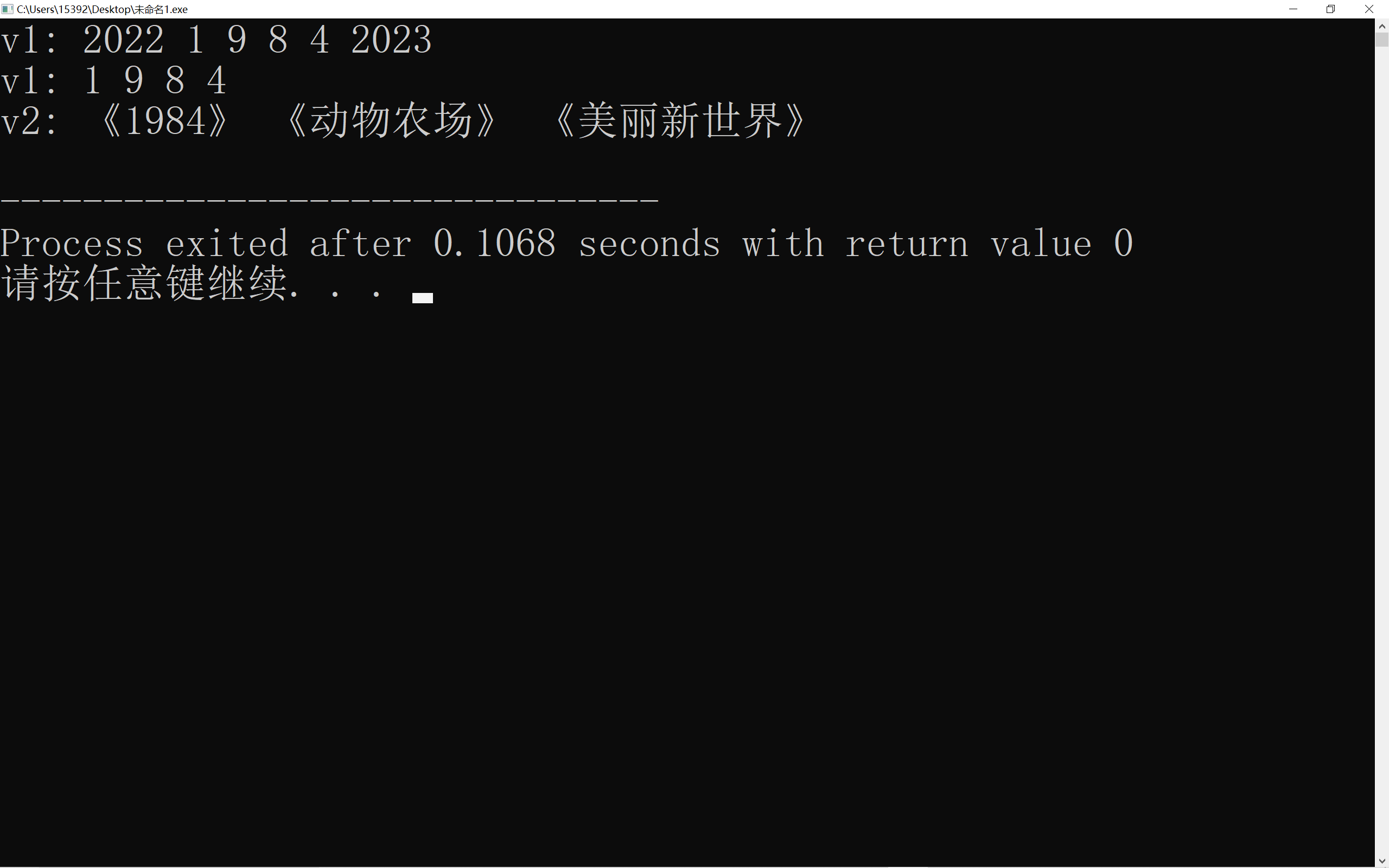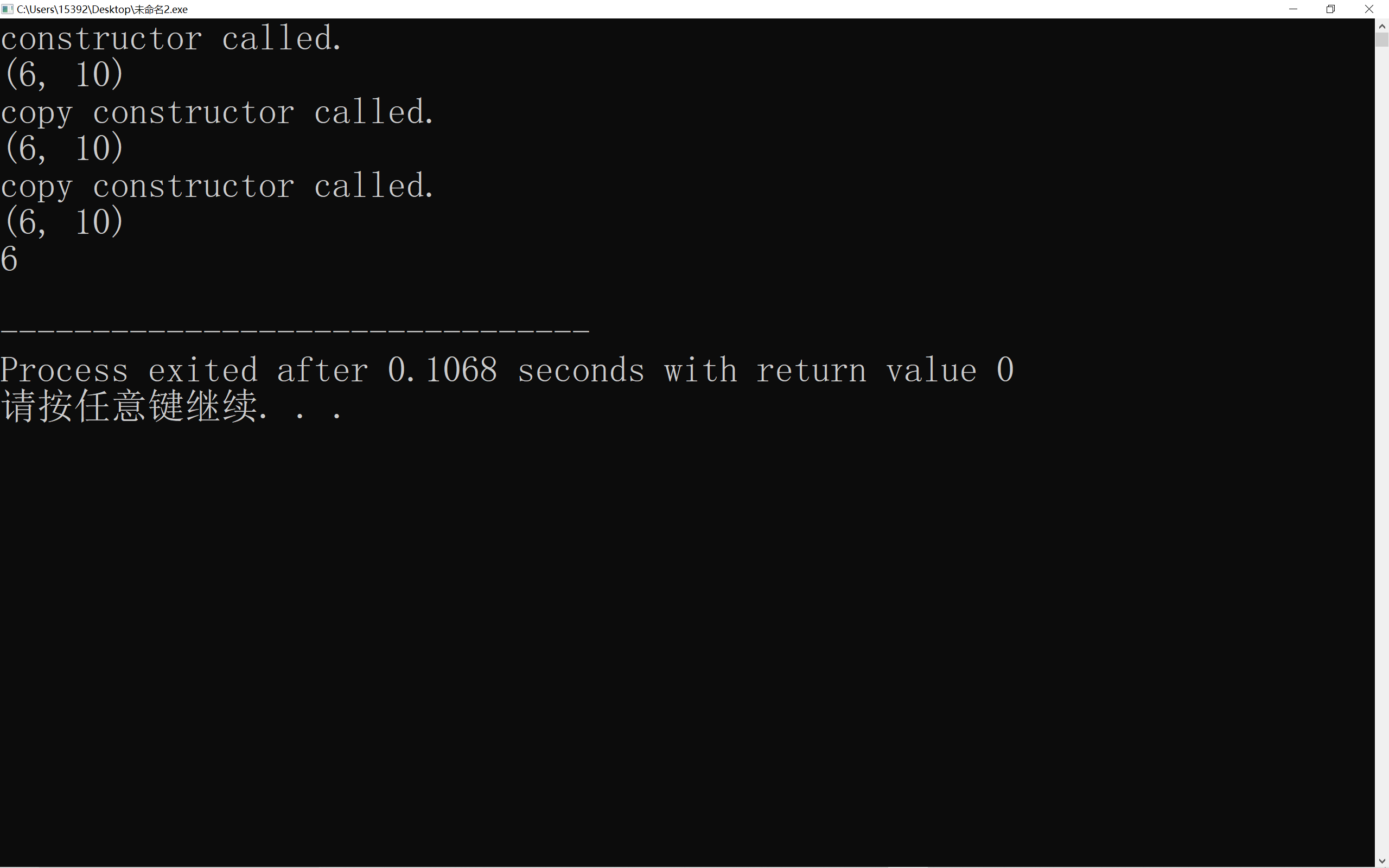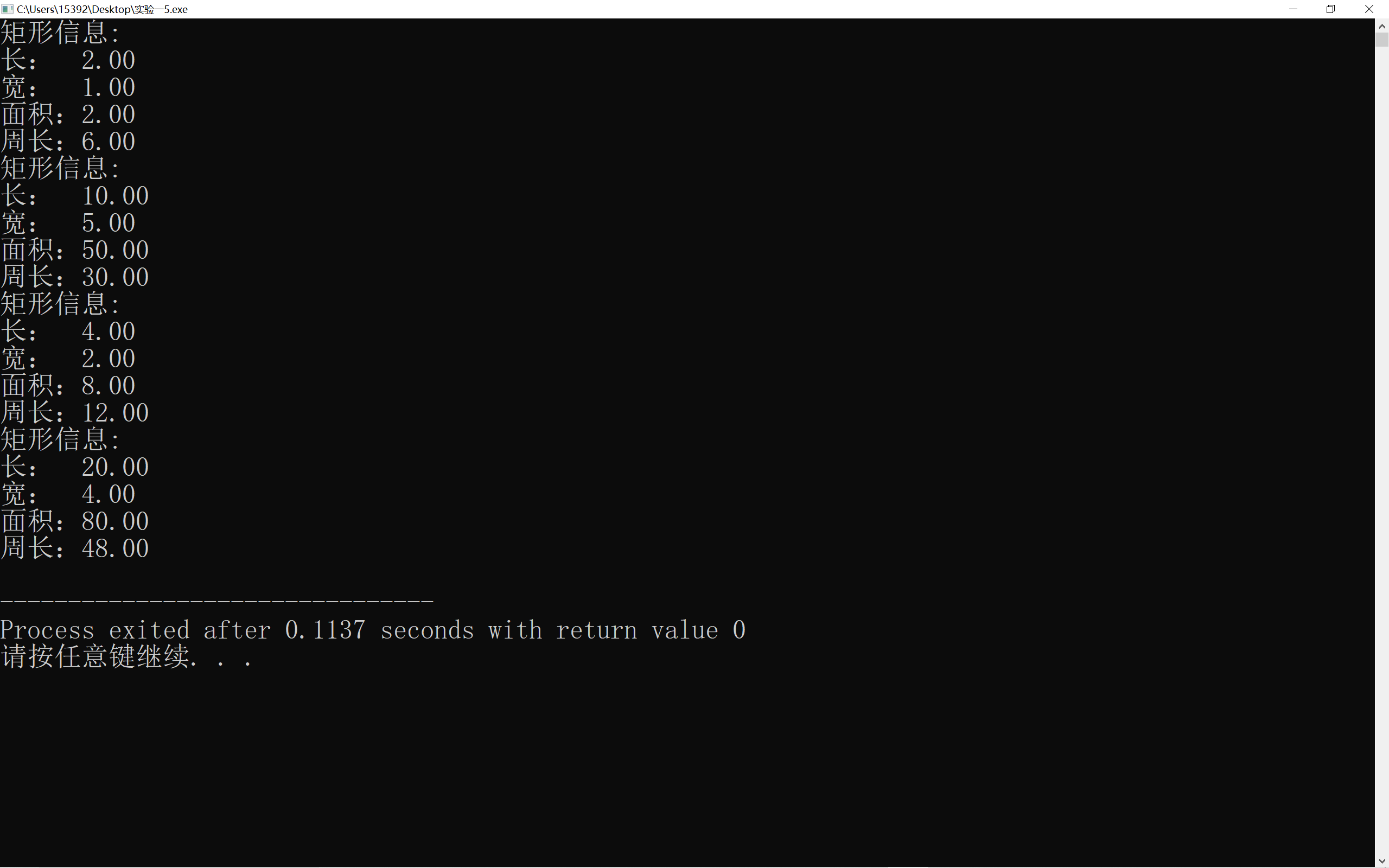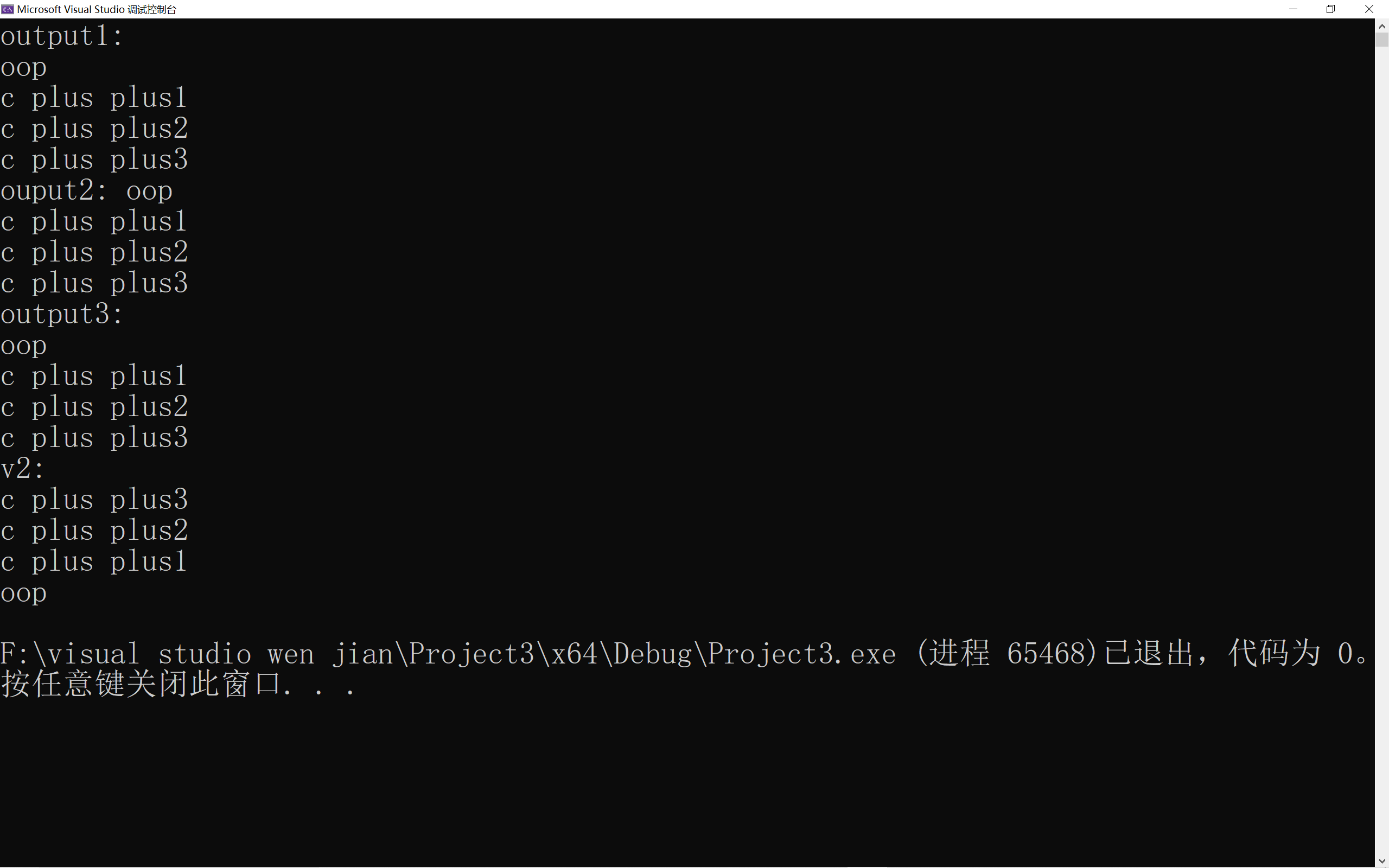实验一
#include <iostream> #include <string> #include <vector> int main() { using namespace std; string s1; // 创建一个string对象 string s2{"c plus plus"}; // 创建一个string对象,并初始化 string s3{s2}; // 创建一个string对象,并用s2对其进行初始化 string s4 = s2; // 创建一个string对象,并用s2对其进行初始化 s1 = "oop"; vector<string> v1; // 创建一个vector对象 v1.push_back(s1); // 向v1末尾添加数据项s1 v1.push_back(s2 + "1"); v1.push_back(s3 + "2"); v1.push_back(s4 + "3"); // 输出方式1:使用自动类型推导、范围for cout << "output1: " << endl; for(auto item: v1) cout << item << endl; // 输出方式2:使用自动类型推导、迭代器 cout << "ouput2: "; for(auto p = v1.begin(); p != v1.end(); ++p) cout << *p << endl; // 输出方式3:使用自动类型推导、索引 cout << "output3: " << endl; for(auto i = 0; i < v1.size(); ++i) cout << v1[i] << endl; vector<string> v2{v1.rbegin(), v1.rend()}; // 使用vector对象v1极其迭代器, //构造对象v2 cout << "v2: " << endl; for(auto item: v2) cout << item << endl;
}
#include <iostream> #include <string> #include <vector> #include <cmath> #include <cstdlib> #include <time.h> // 定义模板函数,用于输出vector容器对象元素的值 template<typename T> void output(const T& obj) // 引用作为函数参数 { for(auto item: obj) std::cout << item << " "; std::cout << std::endl; } int main() { using namespace std; vector<int> v1{1, 9, 8, 4}; v1.insert(v1.begin(), 2022); // 在v1.begin()之前的位置插入 v1.insert(v1.end(), 2023); // 在v1.end()之前的位置插入 cout << "v1: "; output(v1); v1.pop_back(); // 从v1尾部删除数据项 v1.erase(v1.begin()); // 删除v1.begin()位置的数据项 cout << "v1: "; output(v1); vector<string> v2{"《1984》", "《动物农场》", "《美丽新世界》"}; cout << "v2: "; output(v2); }

// Point类 // 相较于教材,在构造函数的写法上,采用了业界更通用的初始化列表方式 #include <iostream> using std::cout; using std::endl; // 定义Point类 class Point { public: Point(int x0 = 0, int y0 = 0); Point(const Point&p ); ~Point() = default; int get_x() const { return x; } // 内联成员函数 int get_y() const { return y; } // 内联成员函数 void show() const; private: int x, y; }; // Point类的实现 // 构造函数(带有默认形参值) Point::Point(int x0, int y0): x{x0}, y{y0} { cout << "constructor called." << endl; } // 复制构造函数 // 参数必须是自身对象的引用类型 Point::Point(const Point& p): x{p.x}, y{p.y} { cout << "copy constructor called." << endl; } void Point::show() const { cout << "(" << x << ", " << y << ")" << endl; } int main() { Point p1(6, 10); // 构造函数被调用 p1.show(); Point p2 = p1; // 复制构造函数被调用 p2.show(); Point p3{p2}; // 复制构造函数被调用 p3.show(); cout << p3.get_x() << endl; }

#include <iostream> #include <iomanip> using std::cout; using std::endl; // 定义时钟类Clock class Clock { public: Clock(int h = 0, int m = 0, int s = 0); Clock(const Clock& t); ~Clock() = default; void set_time(int h, int m = 0, int s = 0); //测试结果: void show_time() const; private: int hour, minute, second; }; // 类Clock实现 Clock::Clock(int h, int m, int s): hour{h}, minute{m}, second{s} { cout << "constructor called" << endl; } Clock::Clock(const Clock& t): hour{t.hour}, minute{t.minute}, second{t.second} { cout << "copy constructor called" << endl; } void Clock::set_time(int h, int m, int s) { hour = h; minute = m; second = s; } void Clock::show_time() const { using std::setw; using std::setfill; cout << setfill('0') << setw(2) << hour << ":" << setw(2) << minute << ":" << setw(2) << second << endl; } // 普通函数定义 Clock reset() { return Clock(0, 0, 0); // 构造函数被调用 } int main() { Clock c1(10, 20, 50); // 构造函数被调用 c1.show_time(); c1 = reset(); // 理论上:复制构造函数被调用 c1.show_time(); Clock c2(c1); // 复制构造函数被调用 c2.set_time(9); c2.show_time(); }

#include <iostream> // 定义一个简单抽象类 class X{ public: X(); // 默认构造函数 ~X(); // 析构函数 X(int m); // 构造函数 X(const X& obj); // 复制构造函数 X(X&& obj) noexcept; // 移动构造函数 void show() const; // 显示数据 private: int data; }; X::X(): data{42} { std::cout << "default constructor called.\n"; } X::~X() { std::cout << "destructor called.\n"; } X::X(int m): data{m} { std::cout << "constructor called.\n"; } X::X(const X& obj): data{obj.data} { std::cout << "copy constructor called.\n"; } X::X(X&& obj) noexcept: data{obj.data} { std::cout << "move constructor called.\n"; } void X::show() const { std::cout << data << std::endl; } int main() { X x1; //默认构造函数被编译器自动调用 x1.show(); X x2{2049}; x2.show(); // 构造函数被编译器自动调用 X x3{x1}; // 复制构造函数被编译器自动调用 x3.show(); X x4{ std::move(x2) }; // 移动构造函数被编译器调用 x4.show(); }

当执行 X x1;时,默认构造函数被调用;
当执行 X x2{2049};时,带有两个参数的构造函数被调用;
当执行 X x3{x1};时,复制构造函数被调用;
当执行 X x4{std::move(x2)};时,移动构造函数被调用;
当所有程序执行完毕后,销毁所有对象。
#include <iostream> #include <iomanip> // 矩形类Rectangle的定义和实现 // 补足代码 // ××× class Rectangle{ public: Rectangle();//默认构造函数 Rectangle(double l,double w);//带有两个参数的构造函数 Rectangle(const Rectangle& rect);//复制构造函数 ~Rectangle();//析构函数 double len() const{return length;} double wide () const{return width;} double area () const{return length*width;} double circumference () const{return 2*(length+width);} void resize(int times){ length*=times; width*=times; } void resize(int l_times,int w_times){ length*=l_times; width*=w_times; } private: double length,width; }; Rectangle::Rectangle():length(2.0),width(1.0){} Rectangle::Rectangle(double l,double w):length(l),width(w){} Rectangle::Rectangle(const Rectangle& rect): length{rect.length},width{rect.width}{} Rectangle::~Rectangle() {} // 普通函数, 用于输出矩形信息 void output(const Rectangle &rect) { using namespace std; cout << "矩形信息: \n"; cout << fixed << setprecision(2); // 控制输出格式:以浮点数形式输出、小数部分保留两位 // 补足代码:分行输出矩形长、宽、面积、周长 // ××× cout<<"长: "<<fixed<<setprecision(2)<<rect.len()<<endl; cout<<"宽: "<<fixed<<setprecision(2)<<rect.wide()<<endl; cout<<"面积:"<<fixed<<setprecision(2)<<rect.area()<<endl; cout<<"周长:"<<fixed<<setprecision(2)<<rect.circumference()<<endl; } // 主函数,测试Rectangle类 int main() { Rectangle rect1; // 默认构造函数被调用 output(rect1); Rectangle rect2(10, 5); // 带有两个参数的构造函数被调用 output(rect2); Rectangle rect3(rect1); // 复制构造函数被调用 rect3.resize(2); // 矩形rect3的长和宽同时缩放2倍 output(rect3); rect3.resize(5, 2); // 矩形rect3的长缩放5倍, 宽缩放2倍 output(rect3); }




